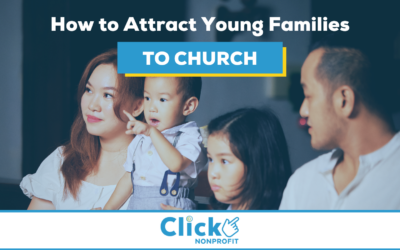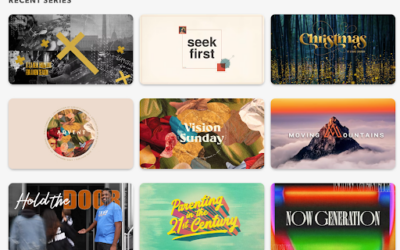If developing an effective social media strategy sounds daunting to you, don’t worry – you are not alone! In a rapidly changing digital landscape, keeping up with shifting trends and best practices can be difficult.
This guide outlines what you need to know in order to build a successful social media presence for your church or ministry. Here you will find information on the benefits of social media, top channels and their demographics, and ways to develop and schedule your content.
Why Social Media?
As with any organization, the use of social media can be vital in reaching your audience and meeting their needs. Unlike the average company, your church does not simply provide material value – the work you do has a spiritual impact. Thus, it’s necessary to engage with your audience in ways that they find meaningful.

Working in ministry, you have been entrusted with a variety of resources, and you have been called to faithfully steward them. If social media falls within your church’s goals and abilities, this guide can help you make the most of your efforts.
Channels
Listed below are some of the most popular social media channels relevant to ministry. You may choose to employ some or all of these; each is unique and provides value for different audiences and types of content.

It seems that nearly everyone is on Facebook; at 2.74 billion users, Facebook is undoubtedly the most popular social media platform. And with capabilities like Facebook Live and Facebook Ads, it’s an excellent choice for churches hoping to build their social media presence.
Facebook users skew slightly male, and the majority of them fall between the ages of 18 and 44. Roughly 7 in 10 Facebook users log onto the app daily, which provides an excellent opportunity to regularly engage with audiences.
Instagram’s 1 billion monthly users skew female (57% to 43%). Similar to Facebook, a third of Instagram users are between the ages of 25 and 34.
Instagram is known for its photo-centric posts. This platform is a key place to highlight your ministry offerings using well-designed graphics and high-quality images. Photos that include faces tend to draw higher engagement – keep this in mind when developing your content strategy.
Additionally, the rise of Instagram Reels creates a promising opportunity for churches to improve reach by creating fun or informative video content.
Unlike on the previous two platforms, Twitter’s demographics are somewhat more focused. Nearly 70% of Twitter users are male and fall between the ages of 30-49. Additionally, this site is home to a higher-educated and higher-paid segment than many other social media platforms.
Twitter is a popular platform for brands to use in joining conversations with followers. Many of its users stay up to date on news and current events via the app. Joining Twitter could be a highly effective way to link to your church’s blog articles or host discussions within your community.
TikTok
If you’re looking to engage with a younger demographic – perhaps hoping to increase awareness of your youth or young adults’ groups – then TikTok may be the right choice for your church’s social media strategy. Its primary demographic is 18-24 year olds and the app is rapidly increasing in popularity.
TikTok is a place to post upbeat, often comedic videos. The key is to keep your content relevant, casual, and authentic. Observe the voices of your audience and cater your posts towards their interests and communication styles.
YouTube
YouTube is not only a social media channel, but is also the world’s second largest search engine (second only to Google). According to Backlinko, 42.9% of internet users use YouTube every month with more than a billion hours of video being watched every single day. The most popular age group on this channel is between 15 and 35.
If your church is set up to livestream your services, YouTube is a great platform on which to do so. Once your services are uploaded, they will be searchable by sermon topic on one of the largest search engines. You can then embed your YouTube videos on your website in the form of a Sermon Library. This way, your church attendees can easily find past sermons on your site.
If your church uses the $10K per month Google Ad Grant, you can drive thousands of people to the embedded sermon videos on your website for free. When someone searches in your area for a felt need like how to save my marriage or God’s view on marriage, you can direct that person to your sermon series on marriage.

Content
When developing a social media strategy for your church, it’s important to post with intentionality. Your content must reflect the goals you have for your ministry and actively contribute to achieving them. Your social media presence should have a consistent voice that aligns with your church’s values. And the types of content you post should pull your followers in, engaging them with relevant information that meets their needs.
Goals
After determining which channels will most effectively reach your target audience, give some thought to the methods that will best deliver your message. Be purposeful about the goals you’re hoping to reach through your social media usage.
Do you want more church members? Focus on building awareness in untapped markets.
Would you like to deepen your relationship with existing members? Actively engage with your followers and find unique ways to start conversations with them via social media.
Perhaps you want to focus on providing spiritual encouragement to your community. Develop a content strategy that is uplifting and informative, and offer ways to get connected and learn more.
Brand Voice
As you prepare to build a content strategy, it’s important to find the proper brand voice. How do you want to interact with your followers? As a hip, trendy friend? As an insightful thought leader? Or as an informative administrator?

In all, you want your social media interactions to be consistent with the church (or the ministry) that you represent. And as followers of Christ, all social media conversations must speak the truth in love, building your community up in godliness. The question of brand identity is a key element in developing a positive social media presence, so dedicate some time to answering it well.
Content Types
The content you post must take into account your community’s needs and interests as well as your services and offerings.
You may choose to inform followers about your service times and ministry locations, or to raise awareness about the need for volunteers. Posting images and videos of your ministry’s events can demonstrate the impact that you are having on your community, and can draw in further participants and supporters.

You may also post your sermons, blogs, and other content on your social accounts. Amidst the COVID-19 pandemic, making your church’s content accessible virtually is especially relevant. Posting to social media can help you minister to others in new ways.
Lastly, you may decide to host a fundraising campaign via social media. Social media has become a popular way to crowdfund for a variety of causes, and can prove profitable for your ministry. Read more about unique ways to fundraise in our recent post, Fundraising Ideas for Churches.
Scheduling
Once you’ve chosen your channels and planned your content strategy, it’s time to schedule your social media posts. You want to choose the times when your followers are most active and ready to engage.

Prime posting times vary based on industry and social platform. For the purposes of this article, the following data refers to both nonprofit industry and industry-agnostic trends. Posting times are listed in Central Standard Time.
In 2021, Wednesdays tend to have the highest engagement rates on Facebook for nonprofit-related accounts. The entire work day (10am-5pm) receives high levels of interaction. Conversely, Saturdays are home to the lowest engagement rates of the week.
Across industries, Facebook’s best days are Tuesdays, Wednesdays, and Fridays from 9am-1pm.
Instagram’s engagement levels are highly similar to Facebook’s. Once again, Wednesday comes out on top (10am-6pm). Sundays are the worst days for posting on Instagram.
Outside of the nonprofit sector, Instagram’s top posting times are Monday-Friday at 11am and Tuesday from 11am-2pm. It may be beneficial to take these times into consideration in order to drive additional engagement.
Twitter’s engagement rates for nonprofits mirror those of Instagram and Facebook, but add a little more variety. Wednesdays from 10-11am and 2-4pm tend to perform well, with Sundays performing poorly.
Across industries, the top posting times for Twitter are Wednesdays from 9am-3pm, and Tuesdays and Thursdays from 9-11am. Once again, Sundays finish last.
TikTok
A new and niche market, TikTok’s prime posting times reflect the app’s unique qualities. The highest levels of engagement are found on Tuesdays at 8am, Thursdays at 11pm, and Fridays at 4am.
Unless you’re planning to be online at all hours of the day (and night), manually posting during TikTok’s high-engagement moments may not be quite as manageable as on other apps. The most important thing you can do is stay up on trends, create quality, relatable content, and engage regularly with your followers. That being said, the use of automated social media scheduling tools – discussed in the next section – can dramatically improve your ability to reach users when they’re online.
YouTube
While a fair amount of discrepancy exists among the recommended best times to post on YouTube, a general rule is that videos will see higher engagement levels near the weekend. This is good news for churches hoping to improve their social media reach, as live-streamed sermons naturally fall on Saturdays and Sundays.
The highest levels of video success are often found on Sundays at 11am and 5pm, and on Fridays and Saturdays from 5-9pm. It would be wise to take advantage of the popularity of video content in developing your church’s social media strategy.
Tools
When publishing your social media posts, you may choose to draft and upload them in the moment, or you may use a content scheduling tool. There is something to be said for spontaneity, and you always want to stay flexible enough to engage with your followers when they’re available.
In general, however, the use of scheduling tools can help you plan for the future and stay on target. Many are free or reasonably priced, and can provide significant benefit for your church’s social media efforts. Below are just two of these tools.
Buffer
By using Buffer for your church’s social media account, you can schedule and publish content, interact with followers, and analyze engagement, all from one location. Buffer offers both free and paid plans.
Later
The free plan offered by Later.com helps you create, plan, schedule, and analyze content. On this site you can set up profiles on most of the social channels discussed in this post, as well as on Pinterest and LinkedIn.
Conclusion
Social media can be a deeply influential factor in expanding the reach of your ministry. Today you’ve learned about the characteristics of the top channels available to you, the content that will resonate with your audience, and the tools and best practices for scheduling and posting that content. You are now equipped to begin optimizing your church’s social media strategy!




